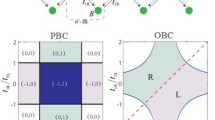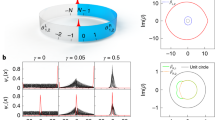Abstract
Non-orthogonality in non-Hermitian quantum systems gives rise to tremendous exotic quantum phenomena, which can be fundamentally traced back to non-unitarity. In this paper, we introduce an interesting quantity (denoted as η) as a new variant of the Petermann factor to directly and efficiently measure non-unitarity and the associated non-Hermitian physics. By tuning the model parameters of underlying non-Hermitian systems, we find that the discontinuity of both η and its first-order derivative (denoted as ∂η) pronouncedly captures rich physics that is fundamentally caused by non-unitarity. More concretely, in the 1D non-Hermitian topological systems, two mutually orthogonal edge states that are respectively localized on two boundaries become non-orthogonal in the vicinity of discontinuity of η as a function of the model parameter, which is dubbed “edge state transition”. Through theoretical analysis, we identify that the appearance of edge state transition indicates the existence of exceptional points (EPs) in topological edge states. Regarding the discontinuity of ∂η, we investigate a two-level non-Hermitian model and establish a connection between the points of discontinuity of ∂η and EPs of bulk states. By studying this connection in more general lattice models, we find that some models have discontinuity of ∂η, implying the existence of EPs in bulk states.

Similar content being viewed by others
References
C. M. Bender, Making sense of non-Hermitian Hamiltonians, Rep. Prog. Phys. 70(6), 947 (2007)
H. Cao and J. Wiersig, Dielectric microcavities: Model systems for wave chaos and non-Hermitian physics, Rev. Mod. Phys. 87(1), 61 (2015)
I. Rotter, A non-Hermitian Hamilton operator and the physics of open quantum systems, J. Phys. A Math. Theor. 42(15), 153001 (2009)
Y. Ashida, Z. Gong, and M. Ueda, Non-Hermitian physics, Adv. Phys. 69(3), 249 (2020)
E. J. Bergholtz, J. C. Budich, and F. K. Kunst, Exceptional topology of non-Hermitian systems, Rev. Mod. Phys. 93(1), 015005 (2021)
R. Lin, T. Tai, L. Li, and C. H. Lee, Topological non-Hermitian skin effect, Front. Phys. 18(5), 53605 (2023)
S. Yao and Z. Wang, Edge states and topological invariants of non-Hermitian systems, Phys. Rev. Lett. 121(8), 086803 (2018)
K. Yokomizo and S. Murakami, Non-Bloch band theory of non-Hermitian systems, Phys. Rev. Lett. 123(6), 066404 (2019)
Z. Yang, K. Zhang, C. Fang, and J. Hu, Non-Hermitian bulk-boundary correspondence and auxiliary generalized Brillouin zone theory, Phys. Rev. Lett. 125(22), 226402 (2020)
W. D. Heiss, The physics of exceptional points, J. Phys. A 45(44), 444016 (2012)
T. Gao, E. Estrecho, K. Y. Bliokh, T. C. H. Liew, M. D. Fraser, S. Brodbeck, M. Kamp, C. Schneider, S. Höfling, Y. Yamamoto, F. Nori, Y. S. Kivshar, A. G. Truscott, R. G. Dall, and E. A. Ostrovskaya, Observation of non-Hermitian degeneracies in a chaotic exciton–polariton billiard, Nature 526(7574), 554 (2015)
B. Zhen, C. W. Hsu, Y. Igarashi, L. Lu, I. Kaminer, A. Pick, S. L. Chua, J. D. Joannopoulos, and M. Soljačić, Spawning rings of exceptional points out of Dirac cones, Nature 525(7569), 354 (2015)
C. Hahn, Y. Choi, J. W. Yoon, S. H. Song, C. H. Oh, and P. Berini, Observation of exceptional points in reconfigurable non-Hermitian vector-field holographic lattices, Nat. Commun. 7(1), 12201 (2016)
D. Zhang, X. Q. Luo, Y. P. Wang, T. F. Li, and J. Q. You, Observation of the exceptional point in cavity magnon-polaritons, Nat. Commun. 8(1), 1368 (2017)
M. A. Miri and A. Alù, Exceptional points in optics and photonics, Science 363(6422), eaar7709 (2019)
S. Wang, B. Hou, W. Lu, Y. Chen, Z. Q. Zhang, and C. T. Chan, Arbitrary order exceptional point induced by photonic spin-orbit interaction in coupled resonators, Nat. Commun. 10(1), 832 (2019)
L. Xiao, T. Deng, K. Wang, Z. Wang, W. Yi, and P. Xue, Observation of non-Bloch parity-time symmetry and exceptional points, Phys. Rev. Lett. 126(23), 230402 (2021)
H. Hu, S. Sun, and S. Chen, Knot topology of exceptional point and non-Hermitian no–go theorem, Phys. Rev. Res. 4(2), L022064 (2022)
F. K. Kunst, E. Edvardsson, J. C. Budich, and E. J. Bergholtz, Biorthogonal bulk–boundary correspondence in non-Hermitian systems, Phys. Rev. Lett. 121(2), 026808 (2018)
C. H. Lee and R. Thomale, Anatomy of skin modes and topology in non-Hermitian systems, Phys. Rev. B 99(20), 201103 (2019)
N. Okuma, K. Kawabata, K. Shiozaki, and M. Sato, Topological origin of non-Hermitian skin effects, Phys. Rev. Lett. 124(8), 086801 (2020)
N. Okuma and M. Sato, Non-Hermitian skin effects in Hermitian correlated or disordered systems: Quantities sensitive or insensitive to boundary effects and pseudo-quantum-number, Phys. Rev. Lett. 126(17), 176601 (2021)
K. Zhang, Z. Yang, and C. Fang, Universal non-Hermitian skin effect in two and higher dimensions, Nat. Commun. 13(1), 2496 (2022)
Z. Lin, H. Ramezani, T. Eichelkraut, T. Kottos, H. Cao, and D. N. Christodoulides, Unidirectional invisibility induced by PT-symmetric periodic structures, Phys. Rev. Lett. 106(21), 213901 (2011)
S. Yao, F. Song, and Z. Wang, Non-Hermitian Chern bands, Phys. Rev. Lett. 121(13), 136802 (2018)
T. S. Deng and W. Yi, Non-Bloch topological invariants in a non-Hermitian domain wall system, Phys. Rev. B 100(3), 035102 (2019)
T. Liu, Y. R. Zhang, Q. Ai, Z. Gong, K. Kawabata, M. Ueda, and F. Nori, Second-order topological phases in non-Hermitian systems, Phys. Rev. Lett. 122(7), 076801 (2019)
S. Longhi, Non-Bloch-band collapse and chiral Zener tunneling, Phys. Rev. Lett. 124(6), 066602 (2020)
K. Zhang, Z. Yang, and C. Fang, Correspondence between winding numbers and skin modes in non-Hermitian systems, Phys. Rev. Lett. 125(12), 126402 (2020)
K. Kawabata, N. Okuma, and M. Sato, Non-Bloch band theory of non-Hermitian Hamiltonians in the symplectic class, Phys. Rev. B 101(19), 195147 (2020)
H. Shen, B. Zhen, and L. Fu, Topological band theory for non-Hermitian Hamiltonians, Phys. Rev. Lett. 120(14), 146402 (2018)
Z. Gong, Y. Ashida, K. Kawabata, K. Takasan, S. Higashikawa, and M. Ueda, Topological phases of non-Hermitian systems, Phys. Rev. X 8(3), 031079 (2018)
K. Kawabata, T. Bessho, and M. Sato, Classification of exceptional points and non-Hermitian topological semimetals, Phys. Rev. Lett. 123(6), 066405 (2019)
K. Kawabata, K. Shiozaki, M. Ueda, and M. Sato, Symmetry and topology in non-Hermitian physics, Phys. Rev. X 9(4), 041015 (2019)
H. Zhou and J. Y. Lee, Periodic table for topological bands with non-Hermitian symmetries, Phys. Rev. B 99(23), 235112 (2019)
L. Herviou, N. Regnault, and J. H. Bardarson, Entanglement spectrum and symmetries in non-Hermitian fermionic non-interacting models, SciPost Phys. 7, 069 (2019)
C. C. Wojcik, X. Q. Sun, T. Bzdušek, and S. Fan, Homotopy characterization of non-Hermitian Hamiltonians, Phys. Rev. B 101(20), 205417 (2020)
P. Y. Chang, J. S. You, X. Wen, and S. Ryu, Entanglement spectrum and entropy in topological non-Hermitian systems and nonunitary conformal field theory, Phys. Rev. Res. 2(3), 033069 (2020)
L. M Chen, S. A. Chen, and P. Ye, Entanglement, non-hermiticity, and duality, SciPost Phys. 11, 003 (2021)
S. Sayyad, J. Yu, A. G. Grushin, and L. M. Sieberer, Entanglement spectrum crossings reveal non-Hermitian dynamical topology, Phys. Rev. Res. 3(3), 033022 (2021)
Y. B. Guo, Y. C. Yu, R. Z. Huang, L. P. Yang, R. Z. Chi, H. J. Liao, and T. Xiang, Entanglement entropy of non-Hermitian free fermions, J. Phys.: Condens. Matter 33(47), 475502 (2021)
L. M. Chen, Y. Zhou, S. A. Chen, and P. Ye, Quantum entanglement of non-Hermitian quasicrystals, Phys. Rev. B 105(12), L121115 (2022)
S. Longhi, Topological phase transition in non-Hermitian quasicrystals, Phys. Rev. Lett. 122(23), 237601 (2019)
Q. B. Zeng and Y. Xu, Winding numbers and generalized mobility edges in non-Hermitian systems, Phys. Rev. Res. 2(3), 033052 (2020)
Y. Liu, X. P. Jiang, J. Cao, and S. Chen, Non-Hermitian mobility edges in one-dimensional quasicrystals with parity-time symmetry, Phys. Rev. B 101(17), 174205 (2020)
Y. Liu, Q. Zhou, and S. Chen, Localization transition, spectrum structure, and winding numbers for one-dimensional non-Hermitian quasicrystals, Phys. Rev. B 104(2), 024201 (2021)
N. Hatano and D. R. Nelson, Localization transitions in Non-Hermitian quantum mechanics, Phys. Rev. Lett. 77(3), 570 (1996)
N. Hatano and D. R. Nelson, Vortex pinning and non-Hermitian quantum mechanics, Phys. Rev. B 56(14), 8651 (1997)
N. Hatano and D. R. Nelson, Non-Hermitian delocalization and eigenfunctions, Phys. Rev. B 58(13), 8384 (1998)
Q. Lin, T. Li, L. Xiao, K. Wang, W. Yi, and P. Xue, Observation of non-Hermitian topological Anderson insulator in quantum dynamics, Nat. Commun. 13(1), 3229 (2022)
C. M. Bender, Introduction to PT-symmetric quantum theory, Contemp. Phys. 46(4), 277 (2005)
J. Wiersig, Nonorthogonality constraints in open quantum and wave systems, Phys. Rev. Res. 1(3), 033182 (2019)
K. Petermann, Calculated spontaneous emission factor for double-heterostructure injection lasers with gain-induced waveguiding, IEEE J. Quantum Electron. 15(7), 566 (1979)
K. G. Makris, R. El-Ganainy, D. N. Christodoulides, and Z. H. Musslimani, Beam dynamics in PT symmetric optical lattices, Phys. Rev. Lett. 100(10), 103904 (2008)
H. Schomerus, Excess quantum noise due to mode nonorthogonality in dielectric microresonators, Phys. Rev. A 79(6), 061801 (2009)
J. Wiersig, A. Eberspächer, J. B. Shim, J. W. Ryu, S. Shinohara, M. Hentschel, and H. Schomerus, Nonorthogonal pairs of copropagating optical modes in deformed microdisk cavities, Phys. Rev. A 84(2), 023845 (2011)
Y. V. Fyodorov and D. V. Savin, 0, Statistics of resonance width shifts cLS cL SI gnature of eigenfunction nonorthogonality, Phys. Rev. Lett. 108(18), 184101 (2012)
K. G. Makris, L. Ge, and H. E. Türeci, Anomalous transient amplification of waves in non-normal photonic media, Phys. Rev. X 4(4), 041044 (2014)
M. Davy and A. Z. Genack, Selectively exciting quasinormal modes in open disordered systems, Nat. Commun. 9(1), 4714 (2018)
M. Davy and A. Z. Genack, Probing nonorthogonality of eigenfunctions and its impact on transport through open systems, Phys. Rev. Res. 1(3), 033026 (2019)
F. Song, S. Yao, and Z. Wang, Non-Hermitian topological invariants in real space, Phys. Rev. Lett. 123(24), 246801 (2019)
T. D. Lee and L. Wolfenstein, Analysis of CP-noninvariant interactions and the A:10, k20 system, Phys. Rev. 138(6B), B1490 (1965)
H. Wang, Y. H. Lai, Z. Yuan, M. G. Suh, and K. Vahala, Petermann-factor sensitivity limit near an exceptional point in a Brillouin ring laser gyroscope, Nat. Commun. 11(1), 1610 (2020)
J. Cheng, X. Zhang, M. H. Lu, and Y. F. Chen, Competition between band topology and non-Hermiticity, Phys. Rev. B 105(9), 094103 (2022)
Z. Oztas and N. Candemir, Su–Schrieffer–Heeger model with imaginary gauge field, Phys. Lett. A 383(15), 1821 (2019)
X. R. Wang, C. X. Guo, and S. P. Kou, Defective edge states and number-anomalous bulk-boundary correspondence in non-Hermitian topological systems, Phys. Rev. B 101(12), 121116 (2020)
W. Zhu, W. X. Teo, L. Li, and J. Gong, Delocalization of topological edge states, Phys. Rev. B 103(19), 195414 (2021)
Y. Zhou, L. M. Chen, and P. Ye, to be appeared (2023)
J. W. Demmel, Nearest defective matrices and the geometry of ill-conditioning, Reliable Numer. Comput. 44, 35 (1990)
C. H. Lee, P. Ye, and X. L. Qi, Position-momentum duality in the entanglement spectrum of free fermions, J. Stat. Mech. 2014(10), P10023 (2014)
C. H. Lee and P. Ye, Free-fermion entanglement spectrum through Wannier interpolation, Phys. Rev. B 91(8), 085119 (2015)
Y. Long, H. Xue, and B. Zhang, Non-Hermitian topological systems with eigenvalues that are always real, Phys. Rev. B 105(10), L100102 (2022)
A. Zettl, Sturm-Liouville Theory, 121, American Mathematical Society, 2012
Acknowledgements
This work was supported by the National Natural Science Foundation of China (NSFC) Grant No. 12074438, the Guangdong Basic and Applied Basic Research Foundation under Grant No. 2020B1515120100, the Open Project of Guangdong Provincial Key Laboratory of Magnetoelectric Physics and Devices under Grant No. 2022B1212010008, and the Fundamental Research Funds for the Central Universities, Sun Yat-sen University (No. 23ptpy05).
Author information
Authors and Affiliations
Corresponding author
Ethics declarations
Declarations The authors declare that they have no competing interests and there are no conflicts.
Rights and permissions
About this article
Cite this article
Zou, YY., Zhou, Y., Chen, LM. et al. Detecting bulk and edge exceptional points in non-Hermitian systems through generalized Petermann factors. Front. Phys. 19, 23201 (2024). https://doi.org/10.1007/s11467-023-1337-8
Received:
Accepted:
Published:
DOI: https://doi.org/10.1007/s11467-023-1337-8




